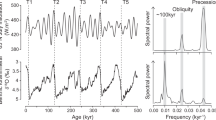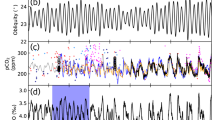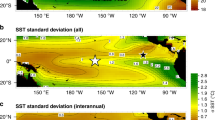Abstract
Between 1.5 and 0.6 Myr ago, the period of the Earth's glacial cycles changed from 41 kyr, the period of the Earth's obliquity cycles, to 100 kyr, the period of the Earth's orbital eccentricity1,2, which has a much smaller effect on global insolation. The timing of this transition and its causes pose one of the most perplexing problems in palaeoclimate research3. Here we use complex demodulation to examine the phase evolution of precession and semiprecession cycles—the latter of which are phase-coupled to both precession and eccentricity—in the tropical and extra-tropical Atlantic Ocean. We find that about 1.5 Myr ago, tropical semiprecession cycles (with periods of about 11.5 kyr) started to propagate to higher latitudes, coincident with a growing amplitude envelope of the 100-kyr cycles. Evidence from numerical models suggests that cycles of about 10 kyr in length may be required to explain the high amplitude of the 100-kyr cycles4. Combining our results with consideration of a modern analogue, we conclude that increased heat flow across the equator or from the tropics to higher latitudes around 1.5 Myr ago strengthened the semiprecession cycle in the Northern Hemisphere, and triggered the transition to sustained 100-kyr glacial cycles.
This is a preview of subscription content, access via your institution
Access options
Subscribe to this journal
Receive 51 print issues and online access
$199.00 per year
only $3.90 per issue
Buy this article
- Purchase on Springer Link
- Instant access to full article PDF
Prices may be subject to local taxes which are calculated during checkout


Similar content being viewed by others
References
Raymo, M. E., Ruddiman, W. F. & Clement, B. M. in Initial Reports Deep Sea Drilling Project: Leg 96 (eds Ruddiman, W. F. et al.) 895–901 (US Government Printing Office, Washington DC, 1986 ).
Ruddiman, W. F., Raymo, M. E., Martinson, D. G., Clement, B. M. & Backman, J. Pleistocene evolution: Northern Hemisphere ice sheets and North Atlantic Ocean. Paleoceanography 4, 353–412 ( 1989).
Hays, J. D., Imbrie, J. & Shackleton, N. J. Variations in the earth's orbit: pacemaker of the ice ages. Science 194, 1121– 1131 (1976).
LeTreut, H. & Ghil, M. Orbital forcing, climatic interactions, and glaciation cycles. J. Geophys. Res. 88, 5167–5190 (1983).
Chen, J., Farrell, J. W., Murray, D. W. & Prell, W. L. Timescale and paleoceanographic implications of a 3.6 m.y. oxygen isotope record from the northeast Indian Ocean (Ocean Drilling Program site 758). Paleoceanography 10, 21– 47 (1995).
Park, J. & Maasch, K. A. Plio-Pleistocene time evolution of the 100-kyr cycle in marine paleoclimate records. J. Geophys. Res. 98, 447–461 ( 1993).
Rial, J. A. Pacemaking the ice ages by frequency modulation of Earth's orbital eccentricity. Science 285, 564–569 (1999).
Hagelberg, T., Pisias, N. & Elgar, S. Linear and nonlinear couplings between orbital forcing and the marine δ18O record during the Late Neogene. Paleoceanography 6, 729–746 (1991).
Raymo, M. E., Ruddiman, W. F., Shackleton, N. J. & Oppo, D. W. Evolution of Atlantic-Pacific δ13C gradients over the last 2.5 m.y. Earth Planet. Sci. Lett. 97, 353–368 (1990).
Bickert, T., Cordes, R. & Wefer, G. in Proceedings of the Ocean Drilling Program, Scientific Results, Leg 154 (eds Shackleton, N. J., Curry, W. B., Richter, C. & Bralower, T. J.) 229–237 (Ocean Drilling Program, College Station, Texas, 1997).
Clemens, S. C., Murray, D. W. & Prell, W. L. Nonstationary phase of the Plio-Pleistocene Asian monsoon. Science 274, 943– 948 (1996).
deMenocal, P. & Bloemendal, J. in Paleoclimate and Evolution with Emphasis on Human Origins (eds Vrba, E. S., Denton, G. H., Partridge, T. C. & Burckle, L. H.) 262–288 (Yale Univ. Press, New Haven, Connecticut, 1995).
Bloemendal, J., Liu, X. M. & Rolph, T. C. Correlation of the magnetic susceptibility of Chinese loess and the marine oxygen isotope record: Chronological and palaeoclimatic implications. Earth Planet. Sci. Lett. 131, 371–380 (1995).
Maasch, K. A. & Saltzman, B. A low-order dynamical model of global climatic variability over the full Pleistocene. J. Geophys. Res. 95, 1955–1963 ( 1990).
Saltzman, B. & Verbitsky, M. Late Pleistocene climate trajectory in the phase space of global ice, ocean state, and CO2: Observations and theory. Paleoceanography 9, 767– 779 (1994).
Herbert, T. D. & Fischer, A. G. Milankovitch climate origin of mid-Cretaceous black shale rhythms in central Italy. Nature 321, 739–743 ( 1986).
D'Hondt, S., King, J. & Gibson, C. Oscillatory marine response to the Cretaceous-Tertiary impact. Geology 24, 611– 614 (1996).
Short, D. A., Mengel, J. G., Crowley, T. J., Hyde, W. T. & North, G. R. Filtering of Milankovitch cycles by Earth's geography. Quat. Res. 35, 157 –173 (1991).
Tiedemann, R., Sarnthein, M. & Shackleton, N. J. Astronomic timescale for the Pliocene Atlantic δ18O and dust flux records from Ocean Drilling Program Site 659. Paleoceanography 9, 619–638 (1994).
Servain, J. & Legler, D. M. Emperical orthogonal function analysis of tropical Atlantic sea surface temperature and wind stress: 1964–1979. J. Geophys. Res. 91, 14181– 14191 (1986).
Merle, J. Seasonal variation of heat-storage in the tropical Atlantic Ocean. Oceanol. Acta 3, 455–463 (1980).
Rodwell, M. J., Rowell, D. P. & Folland, C. K. Oceanic forcing of the wintertime North Atlantic Oscillation and European climate. Nature 398, 320–323 (1999).
Molfino, B. & McIntyre, A. Nutricline variation in the equatorial Atlantic coincident with the Younger Dryas. Paleoceanography 5, 977–1008 (1990).
McIntyre, A. & Molfino, B. Forcing of Atlantic equatorial and subpolar millennial cycles by precession. Science 274 , 1867–1870 (1996).
deMenocal, P. B. Plio-Pleistocene African climate. Science 270, 53–59 (1995).
Clement, A., Seager, R. & Cane, M. Orbital controls on the El Nino/Southern Oscillation and the tropical climate. Paleoceanography 14, 441–456 (1999).
Raymo, M. E., Ruddiman, W. F., Backman, J., Clement, B. M. & Martinson, D. G. Late Pliocene variation in Northern Hemisphere ice sheets and North Atlantic Deep Water circulation. Paleoceanography 4, 413– 446 (1989).
Ruddiman, W. F. & Raymo, M. in Initial Reports of the Deep Sea Drilling Project: Leg 96 (eds Ruddiman, W. F., Kidd, R. B. & Thomas, E.) 855–878 (US Government Printing Office, Washington, 1986).
Bloomfield, P. Fourier Analysis of Time Series: An Introduction 1– 258 (Wiley, New York, 1976).
Ruddiman, W. F., Kidd, R. B., Thomas, E. et al. Initial Reports of the Deep Sea Drilling Program: Leg 96 1251 (US Government Printing Office, Washington DC, 1987).
Acknowledgements
We thank R. Tiedemann for providing the data from Site 659 and M. Raymo for data from Site 607. K. Maasch and M. E. Mann provided helpful comments. This work was supported by the National Science Foundation.
Author information
Authors and Affiliations
Corresponding author
Rights and permissions
About this article
Cite this article
Rutherford, S., D'Hondt, S. Early onset and tropical forcing of 100,000-year Pleistocene glacial cycles. Nature 408, 72–75 (2000). https://doi.org/10.1038/35040533
Received:
Accepted:
Issue Date:
DOI: https://doi.org/10.1038/35040533
This article is cited by
-
Tropical forcing orbital-scale precipitation variations revealed by a maar lake record in South China
Climate Dynamics (2022)
-
Complex population evolutionary history of four cold-tolerant Notopterygium herb species in the Qinghai-Tibetan Plateau and adjacent areas
Heredity (2019)
-
Multiscale analysis of Asian Monsoon over the past 640 ka
Science China Earth Sciences (2019)
-
Sea level history of the northern Gulf of Mexico coast and sea level rise scenarios for the near future
Climatic Change (2011)
Comments
By submitting a comment you agree to abide by our Terms and Community Guidelines. If you find something abusive or that does not comply with our terms or guidelines please flag it as inappropriate.



